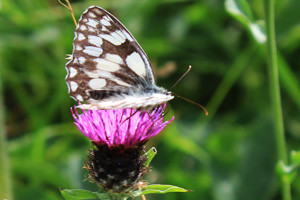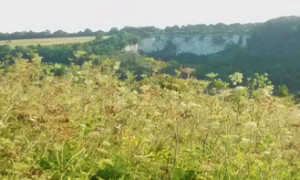Kenley Common
 March, April and May are when the grassland flowering reaches its peak. Expect to find on the chalk such flowers as rough hawkbit, greater knapweed, wild carrot, small scabious, and hawkweed oxtongue. Also found is the oxeye daisy, bush vetch, yellow rattle and even the bushier greater yellow rattle, rare in Britain but common in various Kenley locations. In some years orchids are abundant; these include the common spotted, pyramidal and bee orchids.
March, April and May are when the grassland flowering reaches its peak. Expect to find on the chalk such flowers as rough hawkbit, greater knapweed, wild carrot, small scabious, and hawkweed oxtongue. Also found is the oxeye daisy, bush vetch, yellow rattle and even the bushier greater yellow rattle, rare in Britain but common in various Kenley locations. In some years orchids are abundant; these include the common spotted, pyramidal and bee orchids.
The abundant flowers attract many bees and butterflies, including the striking marble white. Among the many birds, a few skylarks are once again found although only on the airfield at present. Yellowhammers continue to thrive, but the cuckoo has not been heard for a long time. Deer are often seen on the margins of the ancient woodland, and look out for the rare breed sheep and cattle grazing. Keep clear of the electric fences and ensure that all gates are closed behind you.
Foxley Wood
In Foxley Wood, rhododendron flowers May to June. You will find a large swathe of these shrubs along the path from Woodland Way leading to the old gravel pit site. Rhododendron is non-native to this country. It was brought over some 200 years ago from Asia and was probably planted in Foxley Wood by Edmund Byron, lord of the manor of Coulsdon which stretched over as far as Riddlesdown in the 1800’s. Unfortunately the bush does not support insect life and the ground under it is sterile. It needs very aggressive management to stop it spreading.
Sanicle grows along the lower edge of the glade and flowers May to July. It is thought that the name sanicle is a contraction of St Nicholas and another is a derivation of the Latin saunus, meaninghealthy. Whatever, it was used in early times for its supposed healing powers and Culpeper recommended it for curing ulcers and tumours, amongst other ailments.
Primroses are now very scarce in Foxley Wood but you may see the last of them on the path between posts #3 and # 4. However there are many in Dollypers Hill where you can still see a few cowslips.
Herb-robert grows in a large clump by the path at the south-west corner of the glade. The little pink flower can be seen during the summer months until November; “robert” is said to be a corruption of the Latin wordruber, meaning red, a reference to the leaves that turn red in the autumn. The leaves were used in medieval times to staunch the flow of blood.
Dogs mercury grows in very large patches along the lower path. Its presence is said to indicate ancient woodland. It is unusual in that the plant is either male or female and their proximity to each other helps pollination. It has a light fetid smell and, unfortunately, is very poisonous.
Foxley Wood Website
Dollypers Hill
In April and May you will find violets and garlic mustard but in June you are likely to find the common spotted orchid, pyramidal and twayblade. There are also many other plants to see within the various woodlands and the many small clearings that exist. As a point of interest, garlic mustard is also known as jack- by-the-hedge, sauce-alone and even donkey’s foot. It is the food plant of the orange tip butterfly often seen in Spring. Other butterflies to look out for are the common blue, brimstone and skippers. More information www.surreywildlifetrust.org
 Riddlesdown Common
Riddlesdown Common
On the other side of the valley from Kenley, much of Riddlesdown’s 104 acres is a Site Of Special Scientific Interest (SSSI) due to it comprising the ‘largest single expanse of long-established calcareous scrub in Greater London and also for its herb-rich grassland’. An earthworks, old trackways and the course of a Roman road, are some of the remnants of thousands of years of human activity on this site. Lime was extracted from Riddlesdown Quarry (formerly Rose and Crown Pit) which has left the exposed ‘white cliff’ alongside the A22.
Escorted walks
Periodically, there are escorted walks through all of these locations. You will need suitable clothing and dogs are welcome provided they are under control. For more details, visit www.cityoflondon.gov.uk for walks over Kenley Common & www.friendsoffoxley.co.uk for walks and a more detailed description of Foxley Wood. You could also ring Freda on 020 8668 2008. For walks through Dollypers Hill you will need to contact the Surrey Wildlife Trust.

